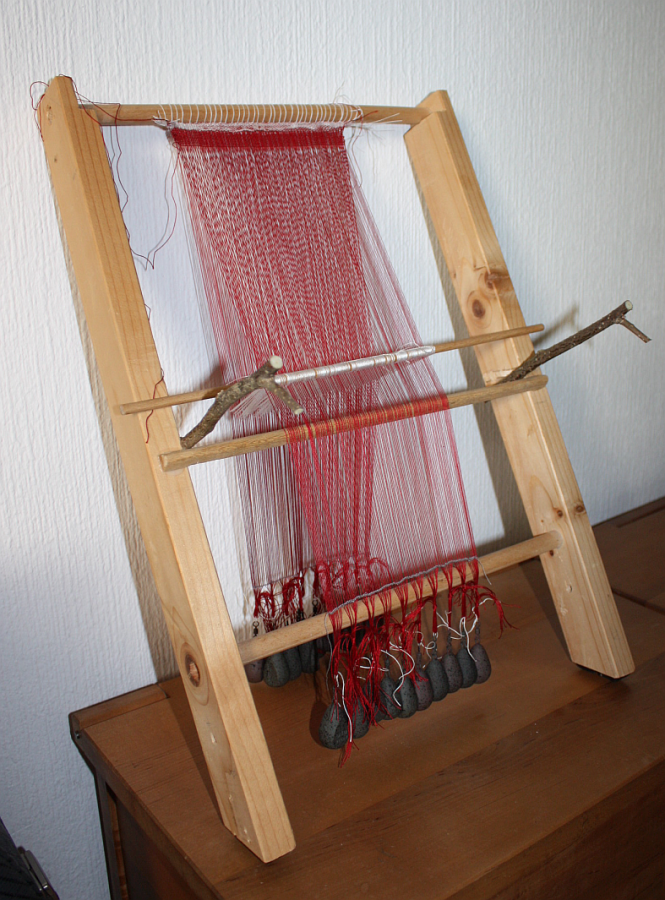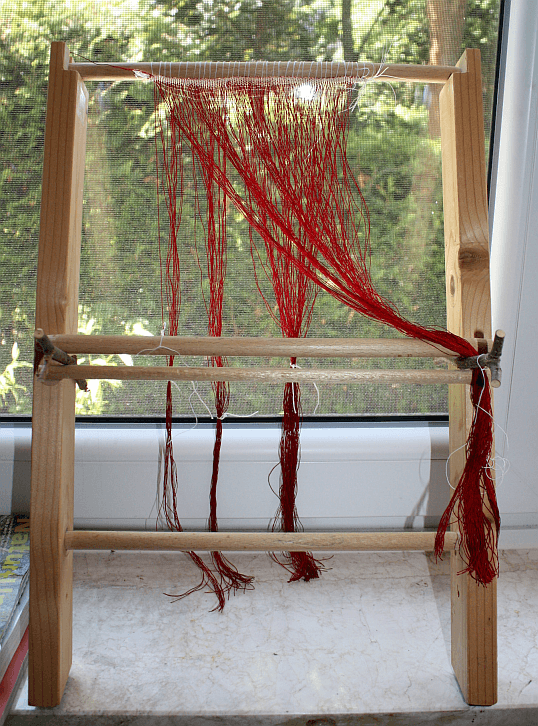Search the Blog
Latest Comments
Katrin
Spinning Speed Ponderings, Part I.
15. April 2024
As far as I know, some fabrics do get washed before they are sold, and some might not be. But I can'...
Kareina
Spinning Speed Ponderings, Part I.
15. April 2024
I have seen you say few times that "no textile ever is finished before it's been wet and dried again...
Katrin
How on earth did they do it?
27. März 2024
Ah, that's good to know! I might have a look around just out of curiosity.
I've since learned that w...
Heather Athebyne
How on earth did they do it?
25. März 2024
...though not entirely easy. I've been able to get my hands on a few strands over the years for Geor...
Katrin
Hieroglyphs.
23. Februar 2024
Yes, that would sort of fit that aspect - but you can also go from bits of woods to sticks if you ar...
More from the Mini-Loom, Part 1: Warping.
The miniature model loom is set up, and functioning, and it was a really fascinating project to do - plus I'm really, really happy with the result. Which looks like this:

Setup took quite a long time - as was to be expected, as I'm a) not super-experienced regarding warping and loom setup, and b) not everything scales down to model size, especially not the time needed to do each individual task.
So... it all started with warping the red threads with help of the white starting border. You set up a warping frame and a rigid heddle for the band (at least that is what I used), weave a few passes on the starting border band, and then you draw loops through each band shed, bringing the loop around the warping frame.
This was a pleasant task, though I did end up with slightly irregular lengths of warp thread, and the edge of my starting border was not as nice as I'd have liked (but that was possible to fix after setting up the warp, at least to an extent). If I had already decided on how many warps to a weight I would set up, I could have separated the batches in this stage; but as everything sort of was still in flow decision-wise, I just did three batches (which also accounts for the warp length irregularity).
Thread length irregularity, by the way, is another thing that will not scale. You'll easily end up with one or two centimetres length difference, maybe even more if you have stretchy thread and real tension issues, and that will be no real issue on a warp length of, say, 2 metres. If your whole warp length is only about 35-40 cm, though, 2 cm difference are a lot, percentage-wise!
So once that warping was done, I attached the starting border to my top beam. On a proper large loom, that beam would have a lever and brake so it could turn to wind the woven cloth onto it. In my model, it is firmly glued in between the sides and thus not turning, so there'll be no demo of how to take up the woven cloth. Should I ever build another model loom, though, I would consider making a proper top beam, even though it adds another weak point in regards to transportability.

You can see the attached warp in its irregular bundles here, and you can also see the very, very messy bottom edge of my starting border, due to bad tensioning in the warp of the border and to bad alignment of the warping setup. (Which I didn't bother to correct, as I was counting on being able to fix it to a good enough state later on. Yes, yes, I know. Shocking.)
The finished warp is about 16 cm wide and has two layers of 109 threads each. Warp threads are a plied mercerised cotton yarn (intended for embroidery, originally) and the starting border is white linen yarn. I had thought about using wool for the cloth, but for several reasons settled on the cotton. First of all: durability. Not that wool isn't durable, mind you - but the model might sit in a basement cupboard for longer periods of time, and I don't want to pull it out again after, say, a year or so to find that some moth has found her way to my loom model and decided it would be a fine thing to feed her offspring. Then, second: scaling/tensioning issues. Wool tends to be a bit stickier than cotton or linen, and that might require more weight per thread, which I'd rather not have; also, doing it properly with wool would have meant doing it properly using single yarns spun in the correct direction, and while I have quite a bit of handspun yarn that might suit hanging around here, with my lack of practice regarding loomy things, I'd rather not do the first try for something like that on a miniature model. So cotton it was.

Setup took quite a long time - as was to be expected, as I'm a) not super-experienced regarding warping and loom setup, and b) not everything scales down to model size, especially not the time needed to do each individual task.
So... it all started with warping the red threads with help of the white starting border. You set up a warping frame and a rigid heddle for the band (at least that is what I used), weave a few passes on the starting border band, and then you draw loops through each band shed, bringing the loop around the warping frame.
This was a pleasant task, though I did end up with slightly irregular lengths of warp thread, and the edge of my starting border was not as nice as I'd have liked (but that was possible to fix after setting up the warp, at least to an extent). If I had already decided on how many warps to a weight I would set up, I could have separated the batches in this stage; but as everything sort of was still in flow decision-wise, I just did three batches (which also accounts for the warp length irregularity).
Thread length irregularity, by the way, is another thing that will not scale. You'll easily end up with one or two centimetres length difference, maybe even more if you have stretchy thread and real tension issues, and that will be no real issue on a warp length of, say, 2 metres. If your whole warp length is only about 35-40 cm, though, 2 cm difference are a lot, percentage-wise!
So once that warping was done, I attached the starting border to my top beam. On a proper large loom, that beam would have a lever and brake so it could turn to wind the woven cloth onto it. In my model, it is firmly glued in between the sides and thus not turning, so there'll be no demo of how to take up the woven cloth. Should I ever build another model loom, though, I would consider making a proper top beam, even though it adds another weak point in regards to transportability.

You can see the attached warp in its irregular bundles here, and you can also see the very, very messy bottom edge of my starting border, due to bad tensioning in the warp of the border and to bad alignment of the warping setup. (Which I didn't bother to correct, as I was counting on being able to fix it to a good enough state later on. Yes, yes, I know. Shocking.)
The finished warp is about 16 cm wide and has two layers of 109 threads each. Warp threads are a plied mercerised cotton yarn (intended for embroidery, originally) and the starting border is white linen yarn. I had thought about using wool for the cloth, but for several reasons settled on the cotton. First of all: durability. Not that wool isn't durable, mind you - but the model might sit in a basement cupboard for longer periods of time, and I don't want to pull it out again after, say, a year or so to find that some moth has found her way to my loom model and decided it would be a fine thing to feed her offspring. Then, second: scaling/tensioning issues. Wool tends to be a bit stickier than cotton or linen, and that might require more weight per thread, which I'd rather not have; also, doing it properly with wool would have meant doing it properly using single yarns spun in the correct direction, and while I have quite a bit of handspun yarn that might suit hanging around here, with my lack of practice regarding loomy things, I'd rather not do the first try for something like that on a miniature model. So cotton it was.
Comments
No comments made yet. Be the first to submit a comment



